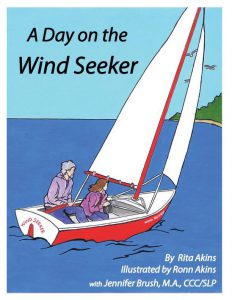It was in 2016 that I was first introduced to the work of award-winning dementia educator, Jennifer Brush, and her use of the Montessori approach with people living with dementia. The focus, first, on what individuals with dementia can do rather than the deficits resonated with my experience as a Montessori educator. I was excited to learn from Jennifer’s work that reading is a preserved ability in dementia and that many individuals, even in the later stages of the disease, enjoy reading aloud to others.
Reading is a preserved ability in dementia . . . many individuals, even in the later stages of the disease, enjoy reading aloud to others.
However, reading material for older adults with cognitive impairment can be limiting. Children’s picture books are sometimes used, but lack relevance for many elders. Jennifer envisioned short, illustrated stories with a specific format that would level the playing field for older adults, allowing a person with dementia to read or partner in the reading of a story. As a Montessori educator and read-aloud advocate, I could see the promise of older adults and young people reading aloud together.
So, we decided to join forces on a read-aloud mission to help individuals living with dementia enjoy a shared reading experience. With Jennifer’s guidance, I wrote and my husband, Ronn, illustrated our first short story, specifically for older adults with cognitive impairment, entitled A Day on the Wind Seeker.
 A Day on the Wind Seeker is a sailing story with a touch of adventure and a bit of fun for old and young. The heart of the narrative lies in the grandfather/granddaughter relationship between the two characters, Papa Jack and Emma. Jack has fond memories of his granddaughter as a young child who loved sailing. Now a teenager, Emma is still “learning new things from her Papa Jack” as they spend a day on the Wind Seeker, an old sailboat they restored together. An endearing grandparent /grandchild relationship plays out as they enjoy the day.
A Day on the Wind Seeker is a sailing story with a touch of adventure and a bit of fun for old and young. The heart of the narrative lies in the grandfather/granddaughter relationship between the two characters, Papa Jack and Emma. Jack has fond memories of his granddaughter as a young child who loved sailing. Now a teenager, Emma is still “learning new things from her Papa Jack” as they spend a day on the Wind Seeker, an old sailboat they restored together. An endearing grandparent /grandchild relationship plays out as they enjoy the day.
There are several features to A Day on the Wind Seeker that facilitate reading for those with dementia. The large-print text of the story is predictably on the left side each time, with the full-page, color illustration on the right. The illustrations are simple and uncluttered, and directly support the interpretation of the text. Colors are bold and contrasting for those with low-vision. There are pauses throughout the story in the form of short questions to prompt conversation and reflection, and to set a comfortable pace. And, finally, the size of the book and the weight of the paper has been calculated to promote easy viewing and handling.
The Wind Seeker has been used in small reading groups in relaxed settings where individuals with dementia take turns reading to each other. Taking turns sets up a kind of “conversation” among participants where they are engaged and contributing as they read without the pressure of trying to think of something to say. Optional open-ended questions that appear at the end of each page bring a pause to the story to prompt the sharing of memories or experiences, encouraging a sense of solidarity among participants.
The Wind Seeker has also been used for one-on-one read alouds, pairing a family member or a care partner, with an older adult. The intergenerational theme of the story invites children, as well, to be reading partners. The dynamics of the partnership are important. The Wind Seeker was written to help individuals with dementia feel the joy of sharing a story with another human being. The responses and reactions of an engaging reading partner can make all the difference. Sitting close, making eye contact, laughing together – these are the interactions that build relationships and foster feelings of closeness and caring so essential to the well being of those with dementia.
Whatever way they choose to read, it is hoped that A Day on the Wind Seeker will empower older adults with a “can do” spirit.
